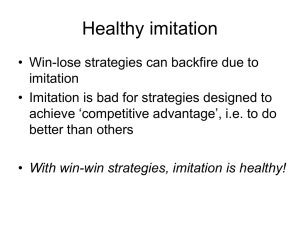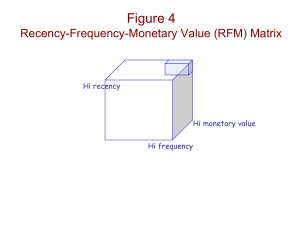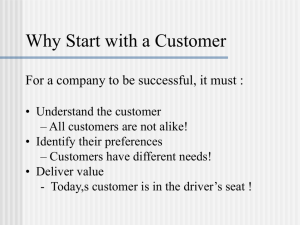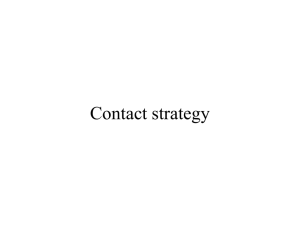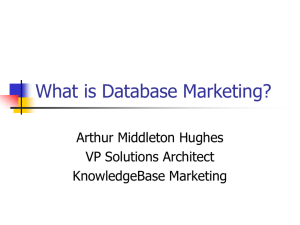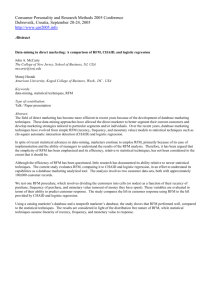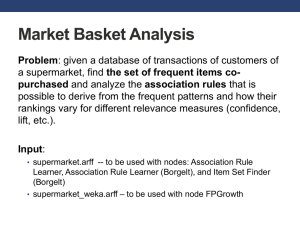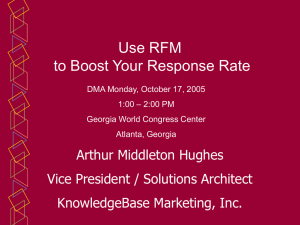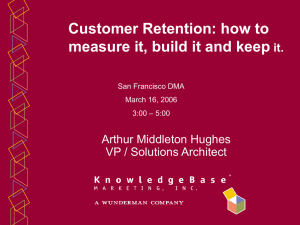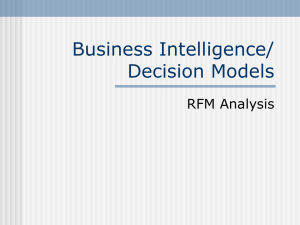UCEA Mini-Workshop on Database Marketing
advertisement
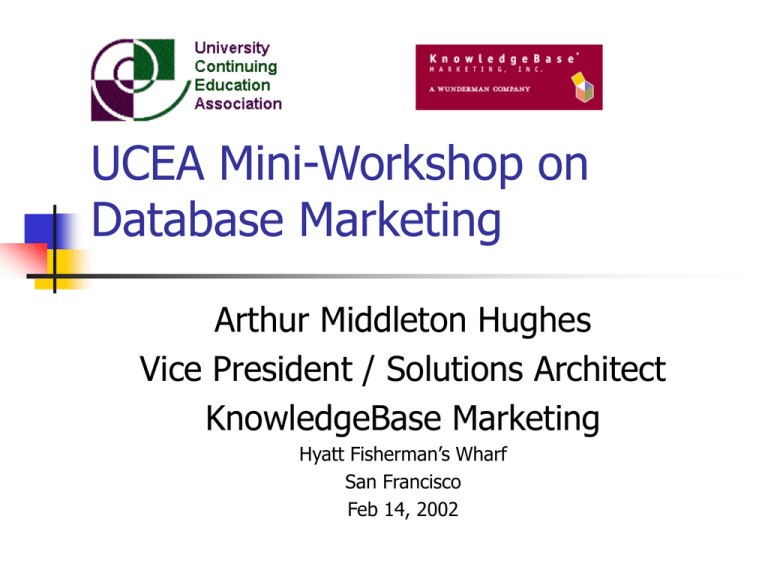
UCEA Mini-Workshop on Database Marketing Arthur Middleton Hughes Vice President / Solutions Architect KnowledgeBase Marketing Hyatt Fisherman’s Wharf San Francisco Feb 14, 2002 What KnowledgeBase Marketing Does Compared with newcomers, Long term customers: Buy more per year Buy higher priced options Buy more often Are less price sensitive Are less costly to serve Are more loyal Have a higher lifetime value Retention is the way to measure loyalty 90% 80% 70% Percentage Retained from Previous Year 60% 50% 40% 30% 20% 10% 0% 1 2 3 4 Years as a customer 5 Retention pays better than acquisition Annual Profit $48 $60 $40 $20 $0 ($20) ($40) ($60) ($80) ($62) New Customer 3rd Year Customer What proves that relationship building works? Manufacturer of building products Catalog sent to 45,000 contractors Previous policy: wait for the orders Test: pick 1,200 customers, split into test of 600 and control of 600 Two person pilot program build relationship with test customers to see the results Credit: Hunter Business Direct What did they offer? Follow up on bids and quotes Schedule product training Make aware of pricing specials Ask about customer needs Product comparison information New Product information They did not offer discounts Improvement in Response rate 76% 76% 76% 75% Percent 75% who 74% purchased 74% in 6 months 73% 73% 72% 72% 73% 1 2 Control vs Test Group Change in the number of orders 112% 120% 82% 100% Change in number of orders 80% 60% 40% 20% 0% 1 2 Control vs Test Groups Change in the Average Order Size 114% 120% 86% 100% 80% Change in average 60% order size 40% 20% 0% 1 2 Control vs Test Group Total revenue gain: $2.6 million dollars 127% 140% 120% 100% Change in total revenue 70% 80% 60% 40% 20% 0% 1 2 Control vs Test Group This stuff works! Building a relationship with customers can be highly profitable Using a database to recreate the old family grocer is a winning strategy Relationship marketing is the way to go Why we need Lifetime Value Analysis We need to know the value of our customers, so as to properly target our sales and retention efforts We need to discriminate among our customers to acquire and retain the best Lifetime Value Analysis Goal: Determine... where to put your retention dollars the value of each retention strategy where to put your acquisition dollars how much to spend on acquisition What is lifetime value? Net present value of the profit to be realized on the average new customer during a given number of years. Lifetime value is “Good Will.” To compute it, you must be able to track customers from year to year. Main use: To evaluate strategy. Retention Rate Students Courses/Year Cost per course Revenue Year 1 Year 2 Year 3 40% 45% 50% 10,000 4,000 1,800 2.8 3.0 3.2 $605 $605 $605 $16,940,000 $7,260,000 $3,484,800 Costs Percent Costs Retention Costs $12 Total Costs 80% 77% 75% $13,552,000 $5,590,200 $2,613,600 $120,000 $48,000 $21,600 $13,672,000 $5,638,200 $2,635,200 Profit Discount Rate NPV Profit Cumulative NPV Lifetime Value $3,268,000 $1,621,800 $849,600 1.00 1.17 1.36 $3,268,000 $1,386,154 $624,706 $3,268,000 $4,654,154 $5,278,860 $326.80 $465.42 $527.89 Discount Rate Basic Formula Market Rate of Interest...6% Assume Risk 1.2 first year, 1.1 afterwards Years = n Interest = i Formula: D = (1 + I * risk)n Calculation of rate after 2 years: D = (1.06 * 1.1)2 = 1.36 Convert to Annual Annual Rate = (Repurchase rate) (1/years) 77% repurchase after 11 years Annual Rate = (.77)(1/11) = 98% 45% repurchase after 4 years = 82% 99% per week = 59.2% per year Annual = (.99) (1/(1/52)) Annual Rate = 59.2% New Retention Strategies Build a database linked to the website Web registration Frequent personal communications Web site cost $30 per student per year Communications extra cost $18 per student per year Retention Rate Students Courses/Year Revenue per Course Revenue Year 1 Year 2 Year 3 45% 50% 55% 10,000 4,500 2,250 3.0 3.5 4.0 $605 $605 $605 $18,150,000 $9,528,750 $5,445,000 Costs Percent Costs Web Costs $30 Retention Costs $30 Total Costs 75% 72% 70% $13,612,500 $6,860,700 $3,811,500 $300,000 $135,000 $67,500 $300,000 $135,000 $67,500 $14,212,500 $7,130,700 $3,946,500 Profit Discount Rate NPV Profit Cumulative NPV Lifetime Value $3,937,500 $2,398,050 $1,498,500 1.00 1.17 1.36 $3,937,500 $2,049,615 $1,101,838 $3,937,500 $5,987,115 $7,088,954 $393.75 $598.71 $708.90 Effect of adoption of new strategies $1.8 million in the third year Profit, after all expenses paid New LTV Old LTV Change Times 10,000 Year 1 $393.75 $326.80 $66.95 $669,500 Year 2 $598.71 $465.42 $133.30 $1,332,962 Year 3 $708.90 $527.89 $181.01 $1,810,094 What is the proper computation period? Which is the correct lifetime value? 1, 2, 3, 4, 5 or more years? They are all correct. Which you use depends on your product or service. Long lifetimes: banks, insurance, utilities. Short lifetimes: continuing education. Five Ways to Boost LTV with DB Strategies Increase the retention rate Increase the referral rate Increase the spending rate Decrease the direct costs Decrease the marketing costs How to use lifetime value Compute a base lifetime value Dream up a new strategy Estimate the benefits and costs Determine whether your new lifetime value goes up or goes down Don’t undertake any new strategy until you can prove it will be successful Find LTV of Customer Segments Many UCEA customers are quite different in their purchase patterns Create actionable segments and determine the value of each Use the results to focus your retention programs and acquisition programs on the most profitable segments Dividing Customers into Three Segments Develop a different strategy for each segment Quantity Degree Candidates 4,000 Retirees 2,000 Job Training 4,000 Total 10,000 LTV $1,126 $329 $482 Total $4,504,000 $658,000 $1,928,000 $7,090,000 Different marketing strategies Job training: market to companies Degree Candidates: market both to companies and individuals Senior Citizens: market to individuals Using lifetime value to get budget approval Database marketing budgets are usually carved from somewhere else You have to prove that you will make better use of the funds than the others Lifetime value can supply testable numbers that CFO’s can understand Base your budget on solid numbers backed up by valid tests What your new budget will buy New LTV Old LTV Change Times 10,000 Year 1 Year 2 Year 3 $393.75 $598.71 $708.90 $326.80 $465.42 $527.89 $66.95 $133.30 $181.01 $669,500 $1,332,962 $1,810,094 Retention Rate Students Courses/Year Revenue per Course Revenue Year 1 Year 2 Year 3 45% 50% 55% 10,000 4,500 2,250 3.0 3.5 4.0 $605 $605 $605 $18,150,000 $9,528,750 $5,445,000 Costs Percent Costs Web Costs $30 Retention Costs $30 Total Costs 75% 72% 70% $13,612,500 $6,860,700 $3,811,500 $300,000 $135,000 $67,500 $300,000 $135,000 $67,500 $14,212,500 $7,130,700 $3,946,500 Profit Discount Rate NPV Profit Cumulative NPV Lifetime Value $3,937,500 $2,398,050 $1,498,500 1.00 1.17 1.36 $3,937,500 $2,049,615 $1,101,838 $3,937,500 $5,987,115 $7,088,954 $393.75 $598.71 $708.90 Using lifetime value to get budget approval Database marketing budgets are usually carved from somewhere else You have to prove that you will make better use of the funds than the others Lifetime value can supply testable numbers that CFO’s can understand Base your budget on solid numbers backed up by valid tests Recency, Frequency, Monetary Analysis How to attract and hold relationship buyers Forget price. Think and talk about quality and service. Build a relationship with the buyer Add value to product and relationship Find way for buyer to build equity Make it expensive to switch How to identify responsive customers Some customers respond, some don’t How can you predict behavior? Best method: look at past behavior Behavioral indicators: Recent purchasers Frequent purchasers Large spenders Responsive customers may not be the most profitable Profitable Customers Responsive Customers RFM LTV Not all responsive customers are profitable Not all profitable customers will respond when you write them. RFM Can Predict Responders Use RFM to select most likely responders Use combination of mail, phone, and emails to responsive relationship buyers. How to Apply Recency Codes Put most recent purchase date into every customer record Sort database by that date - newest to oldest Divide into five equal parts - Quintiles Assign “5” to top group, “4” to next, etc. Put quintile number in each customer record Response Rate Response by Recency Quintile 4.00% 3.50% 3.00% 2.50% 2.00% 1.50% 1.00% 0.50% 0.00% 3.49% 1.25% 1.08% 0.63% 0.26% 5 4 3 Recency Quintile 2 1 How to compute a Frequency Index Keep number of transactions in customer record Sort Recency Groups from highest to lowest Divide into five equal groups Number groups from 5 to 1 Put Quintile number in each customer record Response by Frequency Quintile 2.50% 1.99% 2.00% Response Rate 1.56% 1.31% 1.50% 1.00% 0.92% 0.93% 2 1 0.50% 0.00% 5 4 3 Frequency Quintile How to compute a Monetary Index Store total dollars purchased in each customer record Sort Frequency Groups from highest to lowest Divide into 5 equal groups (Quintiles) Number Quintiles 5, 4, 3, 2, 1 Put Quintile number in each record 1.80% Response by Monetary Quintile 1.61% 1.60% 1.45% 1.46% 1.40% 1.22% 1.23% 2 1 1.20% 1.00% 0.80% 0.60% 0.40% 0.20% 0.00% 5 4 3 Monetary Response to $5,000 Product Percentage of households promoted who purchased 2 1.68 1.5 1.17 0.88 1 0.66 0.5 0.32 0 5 4 3 Monetary Quintile 2 1 RFM Code Construction R 5 F 35 4 34 3 33 2 32 31 1 Database One Sort Five Sorts M 335 334 333 332 331 Twentyfive sorts Appended RFM Codes Creating an Nth 300,000 Records Customer Database For Nth by 10, select every tenth record. Nth 30,000 Records Result will be statistical replica of database Result of Test Mailing to 30,000 # 1 2 3 4 5 RFM 555 554 553 552 551 Mailed 240 240 240 240 240 Response 20 16 13 10 11 Rate 8.15% 6.56% 5.62% 4.33% 4.51% 6 7 8 9 10 545 544 543 542 541 240 240 240 240 240 9 12 6 10 7 3.78% 4.98% 2.88% 4.26% 3.10% 11 12 13 14 535 534 533 532 240 240 240 240 10 9 8 6 4.13% 3.83% 3.35% 2.70% Test Response Rate by RFM Index of Response 0 = Break Even Cell 500 400 300 200 100 0 -100 -200 555 455 355 255 111 Profit from Test Mailing Quantity Rate Goods Sold Mailing Costs Profits (Loss) Amount 402 $40.00 $16,080 30,000 $0.55 $16,500 ($420) Determine Break Even and Test Sizes How to Compute the Response Rate Divide number of responses by number mailed. Multiply by 100 Example: Responses = 1034 Mailed = 40,000 Rate = 1034 / 40,000 Rate = 2.59% Test, Full File & RFM Selects Compared Response Rate Responses Net Revenue No. Mailed Mailing Cost Profits Test Full File RFM Select 1.34% 1.17% 2.76% 402 23,412 15,295 $16,080 $936,480 $611,800 30,000 2,001,056 554,182 $16,500 $1,100,581 $304,800 ($420) ($164,101) $307,000 8.00% Test Vs Rollout Response Rates 7.00% 7.00% 6.00% 6.00% 5.00% 5.00% 4.00% 4.00% 3.00% 3.00% 2.00% 2.00% 1.00% 1.00% 0.00% 0.00% 554 553 552 551 545 544 543 542 541 535 534 533 532 531 525 524 523 522 521 515 514 513 512 511 455 451 445 444 443 355 354 351 344 Retroactive RFM Test Many times there is not enough time or funding to run an Nth test in advance Solution: apply RFM codes to your last completed outgoing promotion. Since you know who responded, you can determine response rates by cell Use previous rates to govern this rollout. How Many RFM Cells Needed? Test File = (Test Budget) / (per piece cost) Example = $15,000 / $0.76 = 19,737 Cells Needed = 19,737 / 274 = 72 Cell Division Determination To create 72 cells, some must be less than 5 Recency most powerful. Do not scrimp. Example R-F-M = 6 X 4 X 3 = 72 Is this best? Test and see. RFM For Business Databases Business databases are small For small databases, use quartiles or thirds Quartile = 4 X 4 X 4 = 64 Cells Thirds = 3 X 3 X 3 = 27 Cells Custom = 5 X 2 X 2 = 20 Cells Recent Case History User sells personalized product by mail 45,000 selected for a test Second Recency Quintile Had More Responses. Why? Even so, First Recency Quintile Had Higher Sales Recent buyers spend more per order Lowest two recency quintiles did not break even Frequency was very predictive of response Monetary did not predict response rate very well But Monetary does predict average sales by quintile RFM Cells clearly show who to mail to, and who to drop When NOT to use RFM If you use it all the time, half your customers will never hear from you They will be lost The others will suffer from File Fatigue Use it sparingly Product launch is ideal use THE COMPLETE DATABASE MARKETER by Arthur Middleton Hughes Chicago: McGraw Hill 600 pp Glossary Revised Edition 1996 This is the bible of database marketing. Over 16,000 copies sold. John Stevenson Exec. VP of Krupp Taylor: "Not only does this book succeed in being clear and accessible, it is also the first complete treatise...The full power and practice of database marketing are here, to be sure. This is the long awaited survival manual for every marketer on the cutting edge. I can't think of a book that is more rewarding." This comprehensive book covers such subjects as how to build customer loyalty, lifetime value calculation, RFM analysis, customer service, telemarketing, fulfillment, hardware and software, clustering and profiling, prospecting, media selection. Order from www.DBMarketing.com STRATEGIC DATABASE MARKETING 2nd Ed. by Arthur Middleton Hughes Chicago: McGraw Hill 2000 400 pp Millions have been spent on database marketing programs that did not work. In this book Arthur Hughes shows how to evaluate strategies in advance using lifetime value analysis. He explains how to use RFM analysis to boost profits. Russ Richmond, President of Grey Direct said: "Well, Arthur has done it again. He has not only integrated the complicated world of databases with the traditional concepts of direct marketing, but he accurately points out the pitfalls and the how-tos. I know of a few careers that would have been saved had this book been available sooner. Without a doubt this will be the cheapest investment you'll make in your database, and perhaps the most important one." Thousands of customer marketing databases are being built. Unfortunately, many mistakes have been made. The reasons for these failures center on one central fault: the inability of marketers to develop logical, practical and winning strategies for their database marketing programs. We must study past mistakes to develop sound principles for marketing strategy. Order from www. DBMarketing.com Thank You
